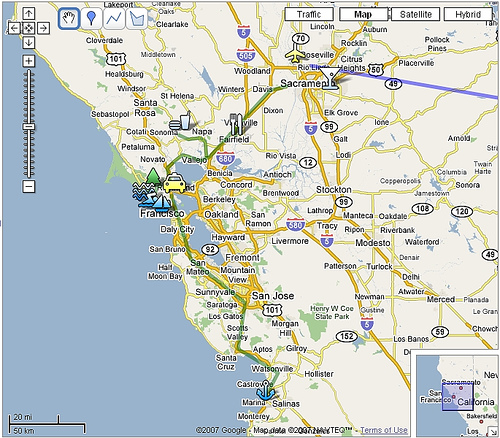You are here
Using Google Maps with Alternative Learners
Primary tabs

billolen
This lesson plan will help students visualize unfamiliar geographic settings. For whatever reason (there’s probably an anthropological explanation), humans around the world are often ignorant of locales 3,000 miles away. Most Americans don’t understand the political distinctions, say, between different sects of foreign religions, and people who have never been to America probably imagine that it’s all like Die Hard or Blade Runner. Some whose first visit to the states included a stop at Austin’s SXSW festival might have found those expectations fulfilled, but I digress.
Given such short-sidedness, this lesson plan is for college-level students who are assigned to read something like Tolstoy’s Hadji Murat, and yet who struggle to understand the historical politics of a place like the mid-nineteenth century Caucus. The strength of the exercise is that it helps students visualize where all sorts of unfamiliar places are on a map. A potential weakness of this exercise is that you’ll encourage underperforming students to rely on the Internet for information. It’s precisely these students, especially if they’re Literature or Rhetoric majors, who instead need encouragement to read more. In any case, humble me is merely proffering up this lesson plan to a caring forum, and we can all keep debating issues like this for the rest of our careers.
Internet access and a Google Account.
When teaching literature, inevitably you will assign a book that involves travel to places that students have never heard of. This could be Bath in Austen’s Northanger Abbey, or Birnam Wood in Shakespeare’s Macbeth. Sometimes, in the case of a Tolstoy story or Nabokov novel, knowing something about these places often provides for a richer thematic understanding of the literary art. This is the sort of knowledge that comes from having read a lot already, and if you’re students haven’t acquired this knowledge from previous reading, you may be looking for ways to instill this learning. In this lesson plan and assignment, you will ask students to make a detailed Google Map for a piece of literature that they find exotic, and then also ask them to write an interpretive essay that digests the map they created.
In the accompanying paper that goes along with this assignment, ask students to interpret a specific work of literature through the map that each individual student has made for that work of literature.
Students need to know how to use Google Maps. Most of them already do, and there are a number of tutorials on YouTube that you can find for them. If students don’t know how to use Google Maps, then you should take the time to teach them.
So, assign your students to make a detailed Google Map for a confusing piece of geographic literature. There are a number of things that I think you should counsel students on as you assign this work. Each student’s map should contain roughly 8 place markers. They should drop place markers in locations that pop up in their work of fiction, and label those pins with important relevant information that they can find on the Internet. In some cases, such as Lolita, many of the towns mentioned are entirely fictional. Rather than smurf your students out of this paradox, I suggest you have them articulate their own way out of it in the accompanying interpretive essay.
Each place marker should contain all sorts of research data. There are any number of ways they can go about filling out this information. The place markers may contain references to some sort of multimedia content or Wikipedia page. It can contain excerpts from the novel in question, or mentions of other works of fiction that also mention these places. Part of what students will glean from this assignment is an understanding of essential information relevant to a quick presentation.
As an instructor, there a two different ways you might consider assessing this work, depending upon your own pedagogical prerogatives. If you’re looking for ways to grade students that don’t involve traditional research and writing, you might put more emphasis on the mapping portion of the assignment. If, on the other hand, the mapping component was simply a leader designed to get students researching in productive ways, you might instead put more emphasis on the writing component. It’s really all up to you.
-

- Log in to post comments

